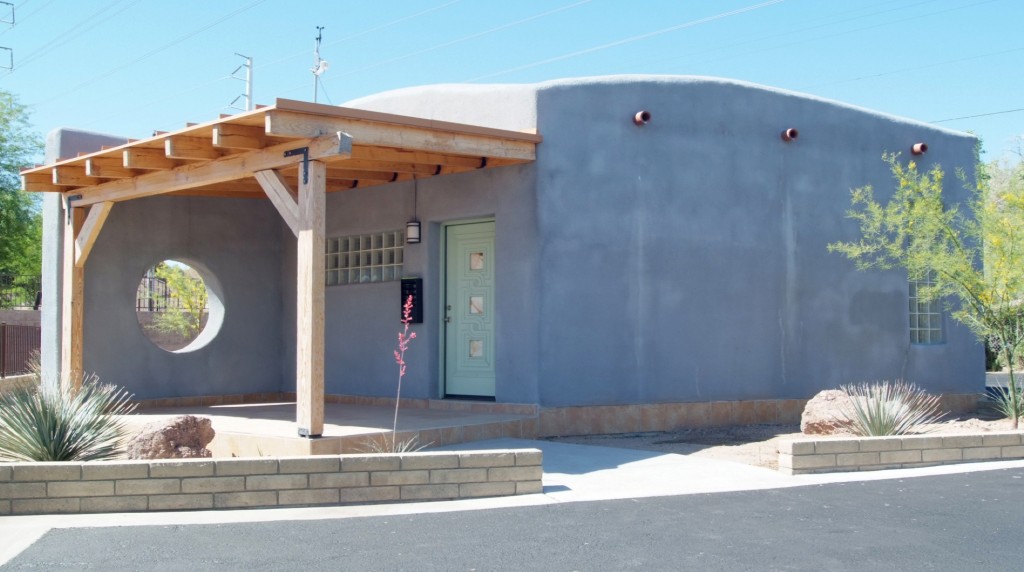
(Photo: Christopher Frettoloso)

(Photo: Christopher Frettoloso)
Creating and building sustainable buildings is the sight on many developers’ and designers’ minds, but how is it done? Christopher Frettoloso of Tempe BetR-blok in Tempe, Arizona, is asking this question as he pushes to find forward thinking products to create sustainable and low cost buildings.
The Arizona-based start-up company Tempe BetR-blok is the for-profit arm of a non-profit organization that researches alternative materials for building. Frettoloso said the idea of the BetR-blok formed from an idea he and his partner developed after there was idea between the two of commercialization opportunity and mass production of a sustainable, affordable building material.
With a DIY approach, BetR-blok wanted to make the material not only easily accessible, but also easy to build for common hands.
“There is really a community of paper creators,” Frettoloso said. “In general, you build a house out of paper and you’re using less labor and less materials.”
The BetR-blok is made with paper — yes paper — like shaded paper, magazine, cardboard and regional material. The material of the block has other perks besides its friendly environmental properties — the block is also fire resistant, water resistant, termite resistant and, more importantly, it’s supportive to hold up structures.
“Everyone has paper news print and cardboard but they have a unique form of delouse,” Frettoloso said.
Affordability is another concept Frettoloso had in mind while creating the sustainable block. Frettoloso said he wanted to highlight not only the environmental aspect of the building block, but also the cost and how it can help homes and businesses save on energy costs.
“Lead with costs and those benefits and how people save money,” Frettoloso said. “Thirty-five percent of the energy that is lost through our house is through the walls.”
The concept over the cost of energy with the BetR-blok has been tested by Frettoloso and his team over the past several of years. The company recently received a grant from the Salt River Project, an energy supplier in Arizona, to build a 500 square foot test structure of their innovative blocks.
In order to monitor the space, a weather stations and data acquisition was put in place to monitor the blocks. Over the course of 3 years, the house was kept at a 76-degree temperature, for a total cost of 18 cents a day. The end of the month bill was 18 dollars. If the calculations of Frettoloso’s project were applied to a bigger space, a 2,000 square foot space kept at the same temperature of 76 degrees would put energy costs at 75 dollars a month.
“With 500 square feet, you can easily multiply those numbers to larger houses,” Frettoloso said.
The testing and approval of the buildings has been no easy process, with hurdles around each corner that Frettoloso and his team have to pay attention to and overcome. Fires testing, water penetration and other tests can often eat up a lot of time and money.
“There’s a lot of hoops you have to jump through when you’re dealing with municipalities,” Frettoloso said. “It’s necessary, we get it. It’s just really expensive.”
As far the future of BetR-blok, Frettoloso said he’s optimistic for the next five to ten years, where he hopes his innovation will reach a mass audience who will not only want to welcome more sustainable products to build their spaces, but also save money on monthly and yearly energy costs.
“Definitely making it a regional thing,” Frettoloso said about the future. “Replicate this across the country.”
The idea of taking and implementing the BetR-blok across the country is entirely possible, according to Frettoloso. By using the base of paper materials and using local materials from a specified place means the block can be recreated from San Francisco to Oklahoma City to Philadelphia. Instead of shipping in materials, local economies are able to be used and cultivated by using regional-specific products to contribute to the block.
“The idea is strategically to place this thing,” Frettoloso said. “Providing the country with different local building materials.”
To learn more about BetR-blok, check out this video!